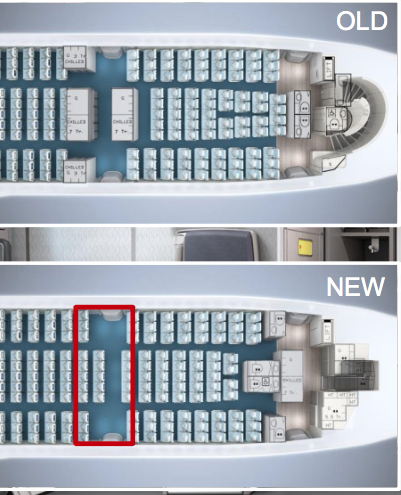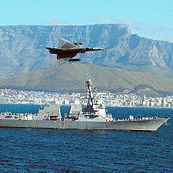Summary of Argument: A 2025 A380-900NEO with large winglets, a revised empennage, A380Plus-style cabin modifications, and perhaps other features seems capable of 35+% per-pax fuel burn reduction, possible trip savings on maintenance and fees, and overall 20+% CASM improvement. The emergence of low-cost longhaul competition to legacy carriers, combined with general traffic increases, could result in a NEO that sells 30-45 frames per year and generates Airbus profits sufficient for ~$3bn investment.
[a.net aside for members: I remain no fan of the A388, still believe it was a waste of opportunity and investment. While I've previously written about VLA futures that involved rewinging the A380 (for ~2021) or its early death so a clean-sheet replacement could be built, it now appears that neither will happen. The best path forward seems Airbus success with an A380NEO. So feel free to think of this post as, "how matt became an A380(NEO) fanboy."].
My standard disclaimers apply: I'm not a professional, I'll be applying basic calculations to the dominant drag/weight calculations, anybody who can do this better or suggest revisions is welcome. I know a little more at the beginning of this thread than I did at the last; hopefully that trend continues.
------------------------------------------------------------------------------
Summary of analyzed A380-900NEO features:
- Stretch by 31ft to fuselage length of 262ft/80m, incorporation of A380Plus cabin modifications and UD door revisions
- Smaller, lighter empennage due to longer lever arm and other factors
- 21ft tall (up+down) scimitar-style winglets, increasing effective span to 290ft
- Engines of Ultrafan generation, contributing 17.5% lower SFC than T900
- "Internal widening" a la 777X to accommodate 11ab seating (not essential but seems beneficial/feasible)
- Possible changes not analyzed: Use of Al-Li, modification of landing gear
Each of these proposed changes requires approximations/assumptions and each interacts with the others, so it's not entirely right to analyze them in isolation. But you have to start somewhere, and I don't want to narrate 100 iterative estimation loops. The following are the components of my estimate settling on ~1,200,000lbs MTOW and slightly weaker engines than the current A388.
Section 1: Capacity enhancements, fuselage weight and wetted area implications
A stretched NEO should fully occupy the 80m box by adding 31ft of fuselage length to reach 262ft. Empennage changes discussed below should keep LOA acceptable.
Deltas:
- Cabin area added: 31ft * (248in + 208in) = 1,178ft2, 109.4m2
- Fuselage wetted area added [assume 25.8ft diameter]: 31*pi*25.8 = 2,512.6ft2; 233.4m2
- Cabin area increases by ~20.1% (over 545m2), fuse Swet by ~14.9% (over 1564m2)
- Assuming A380 Fuse weight (tube-only) is 150,000lbs, and assuming [see note 1] linear escalation with wetted area plus "fudge factor", fuselage weight delta is ~22,400lbs + 4,000lbs = 26,400.
- Delta to floor beams @6lbs/ft2 = ~7,000lbs
- Delta to buyer-furnished equipment (BFE), at 60lbs/pax = ~6,000lbs
- Internal widening weight delta: ~2,000lbs (discussed below)
- Total fuselage weight delta to OEW: ~41,000lbs
Internal widening would occur by narrowing the frame depth on only the lower ~3ft of the MD: ~7.5% of the fuselage circumference. We only want to increase width at seat/armrest level. Actually the "cut" would be gradual from below max cabin width at 258in (eye-level), starting from cabin width of 256in and increasing gradually to 4in (on both sides) down to the floor beams.
- A 33% decrease from the A380's 12in sidewalls would add 8in of cabin width. Enough for a humane 11-abreast (747/777X space standard).
- On basic structural engineering principles, a 33% narrower frame would require 50% more material for equal strength
- Adding 50% to 7.5% of current frame material = 3.75% increase in frame weight
- If frames are 30% of fuselage weight (probably too high), we get 1.125% delta Fuse weight = 1,687.5lbs.
Let's call it 2,000lbs. Seem reasonable? I haven't seen reports that the 777X gained much weight from its sidewall sculpting, which was ~same proportion as this proposal but for a bigger relative portion of fuse diameter. Potential obstacle could be what's in the sidewalls there - would Airbus need to rewire things going through the frames at the proposed point? Idk but that could get ugly... Nonethless they're using only one design software module now (hopefully).
So what's our total capacity delta? Let's start with EK's latest version of the A380 MD seating 437 pax:

Then let's add:
- 30 seats for 11ab
- 14 seats for the aft galley/stairs module.

- 12 seats for front stairs removal, combined captain/crew rest entrance (Airbus says 20 seats but that includes impact on UD, and EK's 2-class layout already has lavs where crew rest usually is):

- 132 seats in 12 rows@31in pitch due to the stretch
- then let's subtract 15% of added seats for galleys/lavs (10 pax/cart, ~.6seat/cart; ~45pax/lav, 2.5seats/lav)
- total seat delta is 160 Y seats
That would give us 597 seats on the MD, probably illegal given our 5 MD exit pairs. So make it 550 seats with 240 Y+ seats, 10ab@35in pitch; 310 Y- seats, 11ab@31in (calculated as Y+ = 1.25*Y-) We now have a good mix of Y+ and Y-, more on that later. Nominally that's a ~26% increase in MD capacity.
On the UD, I'd delete Door 8 (as proposed for A380Plus) and add a door at the front. That enables seating forward, in absence of grand staircase. So we have 31ft extra space from the stretch, plus the foward staircase/lavs area is more useful.
LOPA example:
Let's devote the extra UD space to 9 rows of PY, 7ab@38in. Behind that goes, say, SQ's new UD: 6 F seats, 78 J. That would give us 704 seats (310 Y-, 240Y+, 63 PY, 78J, 6F).
Section 2: Wing enhancement via winglets
IMJ an A380NEO should use the most aggressive deployment of winglets yet seen on an airliner. It has the lowest-AR wing in production and can benefit disproportionately from winglets.
For the A380Plus, Airbus proposed 15ft winglets for 4% fuel burn improvement. IIRC Airbus said the winglets used untapped structural margin (no skin/stringer strengthening for increased bending moment). I couldn't find the direct quote (can anyone?).
On a -900NEO, Airbus would have to beef up the wing anyway, so adding increased bending stress due to effective wingspan gain makes sense.
I'd propose 21ft winglets (bigger seems better but IDK the practical limit). Following the rule of thumb that one gains 2/3 effective span per unit of winglet height, this would increase effective span to 290ft (from current ~267ft per Ferpe/Bjorn).
The 8.6% span increase would cut induced drag by 15%.
Weight delta: let's hold off on this until the end, as bending moment involves fuse/empennage/payload weight as well.
Section 3: Empennage
The A380's empennage's area is 654m2 - 91% of one wing's exposed area. http://www.fzt.haw-hamburg.de/pers/Scho ... _A380.pdf( page 38).
By contrast, the similarly-stubby B788's empennage is only 66% of wing's area: 28% less.
What explains the abnormally large empennage, even relative to the abnormally large wing?:
- Airbus imposed a very low approach-speed constraint (140knots at MLW). Wing Cl is likely highest on approach, the low speed necessitated a huge H-stab sufficient to generate stabilizing/maneuver lift at these low speeds. IMJ this noise benefit is too low to justify the weight/drag expense. Faster-landing planes like 77W don't appear to suffer much, if any, market hit. In any event, the new engines will greatly reduce total vehicle noise. A 10% higher MLW approach speed (154 knots) should allow H-stab area reduction by ~Shstab/1.21.
- Airbus envisioned the A380F entering service shortly after the A388 and finally cancelled it only long after A380 EIS. Airbus did not, AFAIK, plan to build a separate empennage for it. The A380F would have had MLW significantly greater than A388, higher MTOW (~600t), and significantly higher thrust (at least 78k, RR certified up to 84k). These factors would have required greater tail volume; the A388 likely carries that burden now.
- A380's hardware stability design lags the state of the art, as one would expect for an older design. More recent planes like E2 series use advanced FBW to enable lower stability margin (and longer lever arm for given fuselage); the A350 has a good wing/empennage ratio. I've read that Airbus revisions to FBW laws have all but eliminated the A380's trim drag, but it can't shrink the Hstab with clever code.
- Relatively short lever arm compared to LOA
With these parameters in mind, we can posit a new empennage as follows:
- H/V-stab area decreases according to lever arm length (L), measured by distance between the wing's center of pressure and the stabilizer's center of pressure. On the A388, I estimate L at 110ft. This is less than half of LOA, but very-long chords mean that the CP's are farther aft (wing) and forward (stabilizers). 110 is probably a bit high, actually. I posit an 18ft stretch to rear fuse and 13ft stretch to forward fuse. Our relaxed stability margin and lighter empennage should keep the CoG similar or slightly shifted aft despite the fuselage imbalance. [This is an iterative calculation with the empennage parameters]. Accordingly, the lever arm grows by 18/110 = 16.4%.
- H-stab area decreases by 10% for a "Modern FBW" technology factor.
- H-stab area decreases by up to 17%, given our higher minimum approach speed.
- V-stab area related to engine thrust / 84k lbs (max freighter thrust). I'll use 68k thrust here, as we'll end up with lower MTOW (iterative calculation)
Calculations:
- A388 H-stab has 410m2 exposed area (~420m2 wetted, after accounting for camber).
- A389 H-stab modeled at 264m2 = 410 / 1.2 * .9 / 1.164
- A388 V-stab has 244m2 exposed area (~250m2 wetted area)
- A389 V-stab has 175m2 exposed area = 244 / 1.16 * (68/84)
- Total empennage exposed area decreased by 33% to 439m2
A few observations:
-This is a big reduction in empennage size, but we'd still have the biggest empennage by far (~60% bigger than 777-9's H-stab, 80% bigger than 777-9's V-stab).
-I've assumed that the stabilizer's pressure centers didn't move here. That assumption allows us to stay within the 80m box by not overhanging the rear of the fuselage. I'd guess, however, that it would be ok for stabilizers to go a ~5ft past the box, which would allow for a longer lever arm.
Weight implications:
-I've seen typical empennage weight estimates ranging up to 10% of OEW. Whatever the truth, A380 would be at upper end of the range. Most likely the higher estimates include much of empty tail cone in addition to stabilizers.
-I'm going to model the empennage weight delta as (proportional exposed area delta) * 40,000lbs. This seems a compromise between a high estimate and one that ignores all but the stabilizers. The lower lift forces created would mean lighter actuation machinery and less structural stress on the rear fuselage. We're not rebuilding the whole rear fuselage but load/stress paths will necessarily be adjusted during a stretch, and we can harvest some of that via empennage adjustments. Insofar as stabilizers are "wings" that follow square/cube principles, linear weight/area relationship is actually conservative.
-Empennage weight delta = .33 * 40,000 = ~13,000lbs
Section 4: The engines.
I assume we'll use Ultrafan engines or a similarly-good PW/GE product.
Per RR, Ultrafan will have at least 25% lower SFC than original Trent, while the Advance (if built) will show 20% improvement. Ultrafan therefore should show 6.25% lower SFC (.75/.80)
Per Leeham, RR Advance would have 12% lower SFC than T900/GP7200:

So let's say Ultrafan will have 82.5% of the current A388's SFC. [.88 * .9375]
How much thrust do we need? For simplicity's sake let's keep the same T/W as the A388. I calculate below that A389NEO's MTOW should be ~1,200,000lbs. Again, this is an iterative calculation interdependent with our fuselage/empennage weights and Swet's.
The GP7200 and T900 at 72k lbs-T have low thrust/weight ratios and a lot of wetted area relative to thrust. The GEnx/T1000, for example, have lower dry weight, less nacelle Swet, and greater max thrust. Plainly the A388 is carrying bigger, heavier engines meant for the -900 and -800F. Luckily this version won't need more thrust.
RR also plan a shortened core and nacelle for Ultrafan. So despite the higher-BPR and probably slightly-larger fan diameter, I'd expect total engine Swet to be about equal.
Ultrafan shouldn't (IMJ) be heavier per lb-T than current engines: most weight is in the core, which will be shorter, while the larger fan blades will be of advanced material. Assuming 5.5 lbs / lb-T, a 68k Ultrafan engine should weigh ~12,400lbs - ~1,500lbs less than GP7200.
The implied 6,000lbs savings in engine weight is conservative, as dry engine weight is ~60% of propulsion system weight.
Section 5: Performance analysis
Now let's finish estimating an OEW, L/D, and validating/estimating MTOW. So far the weight deltas I've estimated:
- add ~41,000lbs for fuselage+contents
- subtract ~13,000lbs for empennage
- subtract ~6,000lbs for engines
- so far the total delta is +22,000lbs
Now back to the wing:we need to estimate a weight delta from our bigger wing bending moment due to (1) heavier fuse+contents, (2) longer effective span, (3) ligher engines.
Before that, one more diversion: Payload reduction. The A388 has a payload of ~210,000lbs, depending on operator OEW. That seems excessive. If we reduce payload to 180,000lbs, we can still fit 800pax@225lbs. Or 700 pax and 20,000lbs of cargo. Max payload reduction reduces the MZFW wing bending moment, fuselage weight as well.
So in the past I've done spreadsheet modelling of these questions. The only reactions I've had to those efforts are hostility and silence. If we want to dig deeper into the issue (I do), then we should. For now, here's my guess: 15,000lbs of wing reinforcement.
On the A388, span-dependent wing weight is probably ~80,000lbs (~40% of wing weight, which is ~33% of OEW). I've escalated effective span by 8%, but a winglet's span extension doesn't imply the exponential weight implication of longer wings (drawback is added wetted area and winglet weight versus a higher-AR wing of the same area). So a 15,000lb delta is ~19% delta to span-dependent wing weight.
19% is a lot. And we haven't considered the effect of lower fuel storage in the wing at MTOW plus lighter engines, which has a secondary impact of decreasing the downward deflection of wings in the +2g "taxi bump" case.
Ok so that's my weight delta estimate. From a baseline A388 OEW of 616,000lbs, our A389NEO OEW is 653,000lbs.
What's our L/D? I'm gonna take a shortcut here and go by a (slightly) adjusted ratio of "Wetted Aspect Ratio" (WAR) = Span^2 / Swet
- Effective span delta is 290 / 267 = 8.61%
- A380 Swet estimated at 3,960m2
- A389NEO Swet delta = 233.4 [fuselage stretch] - 215.4 [empennage shrink] + 40 [winglets] = 58m2
- BUT, fuselage fineness increase means Fuselage Cdp decreases by 2%. Effective fuselage Swet delta is ~197m2
- For WAR calculation purposes, A389NEO Swet is 3,980m2
- L/D ratio is proportional to SQRT (WARA389NEO / WARA388)
- A389NEO has 8.3% higher L/D, per model
Now the money question: what's the relative fuel burn and range? For that let's use the basic Breguet range equation and compare a 489-seat A388 (OEW = 616,000lbs) to a 601-seat (+23%) A389NEO (OEW=653,000lbs), with both planes flying to the A388's max pax-only range.
Breguet equation:
Range = L/D * Speed * ln (MTOW / MLanding))/SFC
Speed is the same, we know our modeled L/D, SFC, and MLanding (=OEW+pax) for each plane. So if we assume equal max range we can solve for the necessary MTOW and mission fuel burn.
Solving the equations, we get the A380-900NEO's MTOW at 1,200,000lbs. (again - I'm presenting the outcome of iterations, all the foregoing modeled parameters are interdependent.)
The A389NEO burns 23.3% less fuel for the trip, which means 37.6% lower fuel/pax (!!!!!).
---------------------------------------------------------------------------------------------------------------------------------
If these numbers are in the ballpark, we can probably all see that an A380-900NEO could be an attractive plane, assuming that Airbus uses aggressive winglets and trims the empennage. In fact, the (parasitic) drag savings from empennage reduction can more than compensate for the added fuselage drag on (IMJ) reasonable assumptions about the new empennage.
I'm going to post my thoughts about operating economics and market size later - both because of fatigue and in case anyone wants to point out some conceptual or arithmetic error before I move on.
In general, I think the A380-900NEO could be a good airliner By that I mean it would offer a capacity/efficiency tradeoff that is at least on trend with the broader landscape. Maybe its efficiency motivates some airlines to move out of their frequency comfort zone. As many members here know, I don't think that's the case with A388 (and wouldn't have been with ~2020 NEO). It's entirely possible that Airbus could build this plane and sell 30 or maybe 45 per year some day. And now I hope it happens. It's the only real shot we have at seeing a great VLA offering compelling economics and broadly expanding travel as have the great travel innovations of the past. Time to cheer for the A380.








